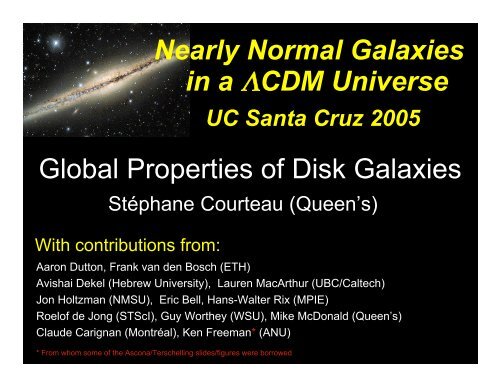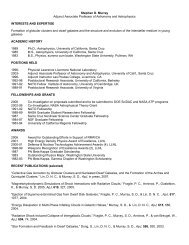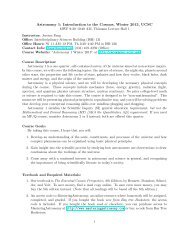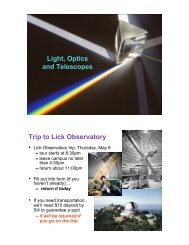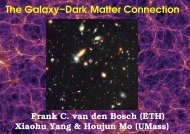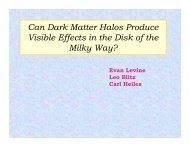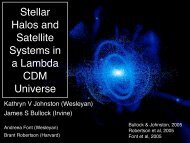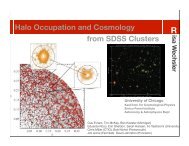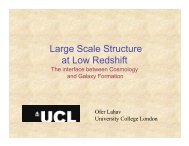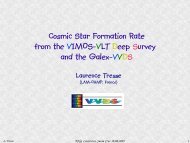Stéphane Courteau
Stéphane Courteau
Stéphane Courteau
Create successful ePaper yourself
Turn your PDF publications into a flip-book with our unique Google optimized e-Paper software.
Nearly Normal Galaxies<br />
in a ΛCDM Universe<br />
UC Santa Cruz 2005<br />
Global Properties of Disk Galaxies<br />
<strong>Stéphane</strong> <strong>Courteau</strong> (Queen’s)<br />
With contributions from:<br />
Aaron Dutton, Frank van den Bosch (ETH)<br />
Avishai Dekel (Hebrew University), Lauren MacArthur (UBC/Caltech)<br />
Jon Holtzman (NMSU), Eric Bell, Hans-Walter Rix (MPIE)<br />
Roelof de Jong (STScI), Guy Worthey (WSU), Mike McDonald (Queen’s)<br />
Claude Carignan (Montréal), Ken Freeman* (ANU)<br />
* From whom some of the Ascona/Terschelling slides/figures were borrowed
Nearly Normal Galaxies<br />
in a ΛCDM Universe<br />
UC Santa Cruz 2005<br />
Many workshops on Disk Galaxies<br />
this summer, including:<br />
• The Formation of Disk Galaxies<br />
Ascona, Switzerland (June 26-July 1)<br />
• Island Universes: Structure and<br />
Evolution of Disk Galaxies<br />
Terschelling, Netherlands (July 3-8)
Ascona/Terschelling Highlights<br />
• Many new (and some old) results on disk galaxies<br />
– The disk is the end product of the dissipation of most<br />
of the baryons, and contains almost all of the baryonic<br />
angular momentum<br />
– Understanding its formation is the most important goal<br />
of galaxy formation theory.<br />
• Brief summary restricted to some highlights<br />
– Structure and properties of extended stellar disks<br />
– Thick disks (bulges, bars, peanuts) & streams<br />
– Expanding horizons: panchromatic surveys<br />
– CDM problems: bulge-less exponential disks,<br />
solid-body rotation curves, …
Ascona/Terschelling Highlights<br />
• Heroic star counts in M31<br />
(Ferguson/Chapman/Guhathakurta/Worthey)<br />
– Very extended structure<br />
(disk>50 kpc; halo to 150 kpc?)<br />
– Disk or metal-poor halo?<br />
– kinematics, [Fe/H]<br />
• UV & Hα evidence for faint outer disks<br />
(Bland-Hawthorne, Zaritsky)<br />
• Origin of these components?<br />
– Star formation threshold?<br />
– Is there a link with presence of HI warp or flare?
The outer regions of M31<br />
Worthey, Espana, MacArthur & <strong>Courteau</strong> 2005<br />
HST photometry in the outermost<br />
regions of M31 yields stellar<br />
metallicity distribution<br />
The metallicity gradient bottoms<br />
out at R=15kpc, at [Fe/H] = -0.5<br />
The high [Fe/H] in the outer<br />
parts of M31 suggests that most<br />
of the stars in the outer “halo”<br />
might be stars of the outer disk.
Ascona/Terschelling Highlights<br />
Galactic open clusters<br />
• abundance gradient<br />
bottoms out at<br />
R G = 10-12 kpc,<br />
[Fe/H] = -0.5<br />
for clusters with<br />
ages from 1 to 5 Gyr<br />
(no age-abundance<br />
relation)<br />
• The abundance gradient<br />
in the disk has flattened<br />
with time, tending<br />
towards solar values.<br />
• outer disk is α-enhanced<br />
Yong & Carney 2005
Ascona/Terschelling Highlights<br />
• New evidence that the disk of M31 goes out to > 50 kpc<br />
= 10 scale lengths (maybe to 150 kpc: Guhathakurta et<br />
al. 2005<br />
• Kinematics of red giants confirms that the outer disk is<br />
rotating almost as rapidly as the inner disk (Ibata et al<br />
2005) and has a velocity dispersion of ~ 30 km s -1 )<br />
• The CMD of M31 suggests that the outer disk is<br />
probably fairly old (several Gyr), as in M33 and the MW<br />
• Outer disk of M31, like the MW, is α-enhanced,<br />
with [α/Fe] = + 0.2 (also Eu-enhanced): indicates<br />
fairly rapid star formation history in the outer disk,<br />
unlike the solar neighborhood.
Ascona/Terschelling Highlights<br />
Summary of outer disks<br />
• The disks of some spirals (NGC 300, M31) extend out<br />
beyond 10 scale lengths.<br />
• The outer disks of M31, M33 and the MW<br />
include a component that is at least several Gyr old.<br />
• The abundance gradients in the outer disks of M31<br />
and the MW bottom out at [Fe/H] = - 0.5<br />
• The older stars of the outer galactic disk are<br />
α-enhanced, indicating that they formed rapidly.<br />
This α-enhancement is less for the younger stars<br />
of the outer disk<br />
• Outer disk stars formed from reservoir of gas that<br />
had a different star formation history from the solar<br />
neighborhood. Star formation may be triggered by<br />
a merger event in the outer disk.
Ascona/Terschelling Highlights<br />
• Most disk galaxies have additional, thick, disk<br />
(Yoachim/Dalcanton)<br />
– Modest mass fraction,<br />
but increases below<br />
v c~120 km s -1<br />
– Some counter-rotate:<br />
⇒ external origin<br />
– Heavier counter-rotating<br />
disks seen in S0s<br />
(Kannappan)<br />
• [α/Fe] vs [Fe/H] in MW thick disk ⇒ it cannot have<br />
formed by accretion of small stellar lumps (Venn)<br />
• Origin in gas-rich merger (Sommer-Larsen)
NGC 4244<br />
Hint of a thick disk<br />
Two pure disk galaxies<br />
vdK&S<br />
NGC 5907
NGC 4656: small bulge<br />
and prominent thick disk<br />
vdK&S
Ascona/Terschelling Highlights<br />
What is the origin of this disk truncation - common and seen<br />
more easily in edge-on galaxies than in face-on galaxies<br />
Kregel etal (2002):<br />
R max/h R = 3.6 ± 0.6<br />
for 34 edge-on disk<br />
galaxies<br />
Perez (2004) finds<br />
similar results at<br />
0.6
Ascona/Terschelling Highlights<br />
Disk truncations<br />
M33 surface brightness<br />
profile<br />
(Ferguson etal 2003)<br />
Sharp decrease in SB<br />
beyond 5 disk scale<br />
lengths.<br />
Star<br />
counts<br />
Light profile<br />
(reaches V~31 mag arcsec -2 !)
Ascona/Terschelling Highlights<br />
Disk truncations<br />
NGC 300* surface<br />
brightness profile<br />
(Bland-Hawthorne<br />
etal 2005)<br />
Exponential profile<br />
extends to 10 disk scale<br />
lengths without a<br />
truncation!<br />
* Similar to M33<br />
Light profile<br />
NGC 300 M33<br />
Light profile<br />
Star<br />
counts<br />
Star counts
Interpretations of disk truncations<br />
• The radius associated with the maximum angular momentum<br />
of the disk baryons in the proto-galaxy -- unlikely -- many<br />
disks have HI extending far beyond the truncation radius<br />
Star<br />
counts<br />
Light profile<br />
• The radius to which the disk has grown today -- unlikely --<br />
The outer disks may be younger but still typically many<br />
Gyr old (eg Bell & de Jong 2000; Ferguson et al 2003).<br />
In some galaxies (eg M83, Milky Way), star formation<br />
continues in the outer disk but there is an underlying old<br />
component.<br />
• The radius where the gas density goes below the<br />
critical value for star formation (Kennicutt 1989) -<br />
star formation regulated by disk stability -- likely.
Ascona/Terschelling Highlights<br />
• Disk truncation is not understood yet: remains an<br />
interesting problem<br />
• Beautiful multi-wavelength high-resolution imaging<br />
– From UV (GALEX) via HST to Spitzer and HI/CO<br />
– Kennicutt, Regan, Murphy/Braun et al.<br />
• Systematic representative surveys (e.g. SINGS)<br />
– Separation of stars and different types of dust<br />
– Get full SED’s, star formation rates, resolved structures<br />
• Key challenge is to model all this in detail (Dopita)
0.15 µm 0.4-0.8 µm 1.2-2.2 µm 3.6 µm<br />
8.0 µm 24 µm 70 µm 160 µm
ΛCDM Structure Formation Models<br />
Small scales, big problems?<br />
• Scaling relations normalization<br />
– Cannot simultaneously predict LF and TF zero-points<br />
• Central regions too dense<br />
– Predicted dark matter halos have more mass near center<br />
(too cuspy) than allowed by observed rotation curves<br />
• Angular momentum crisis<br />
– Disk galaxies are too small for given rotation speed<br />
– Predicted distribution of specific angular momentum<br />
different from observed<br />
• Too much substructure<br />
– Galaxy size dark matter halos have hundreds of sub-halos,<br />
but Milky Way has only ~10 satellites<br />
• Backwards Colour-Luminosity relation<br />
– Lack of very luminous galaxies<br />
– Colour-magnitude relation of spiral galaxies (Bell et al 2003)
ΛCDM Formation Models<br />
• Failures:<br />
– LF normalization & TF zero-point simultaneously<br />
Log V rot (km s -1 )<br />
M I – 5 log(h)<br />
Navarro & Steinmetz (2000)<br />
Abadi etal (2003)
ΛCDM Formation Models<br />
• Failures:<br />
– LF normalization & TF zero-point simultaneously<br />
– Disk size (angular momentum “problem”)<br />
Log j disk (km s -1 h -1 kpc)<br />
Log V rot (km s -1 )<br />
Navarro & Steinmetz (2000)<br />
Abadi etal 2003)
ΛCDM Formation Models<br />
• predictions:<br />
– Hierarchical formation: small structures<br />
collapse first (youngest / massive galaxies<br />
form in clusters today)<br />
– Galaxies evolve inside-out<br />
– “Universal” (NFW) halo profiles<br />
– Sub-maximal disks: DM dominates at all radii<br />
(for R > 1 disk scale length)<br />
mass distribution on all scales is an<br />
important constraint of cosmological models
Mass Modeling: Dutton etal (2005)<br />
• Ingredients:<br />
– Hα + HI rotation curves (Blais-Ouellette 2000)<br />
– R-band surface brightness profile<br />
– gas density profile<br />
– adiabatic contraction<br />
Blumenthal et al. (1986)<br />
(verified by Jesseit etal 2002; Wilson 2003; Gnedin etal 2004;<br />
Sellwood & McGaugh 2005; Kazantzidis etal 2005)<br />
– (disk thickness, oblate halos)<br />
€<br />
• Assume disk M/L and invert light profile ⇒ V disk<br />
2 2 2 2<br />
Vobs = Vdisk + Vgas + Vhalo<br />
rM(r) = const<br />
• Free parameters: disk M/L, halo (α, c, V 200)
Effect of Adiabatic Contraction<br />
(same disk ϒ d)<br />
Final<br />
Initial (NFW)<br />
Without adiabatic contraction, χ 2 = 1.7, v 200 = 91, c = 14.8<br />
Dutton et al (2005)
Mass Modeling Degeneracies<br />
fixed M/L α = 1 (NFW) fixed c<br />
Dutton, <strong>Courteau</strong>, de Jong, & Carignan (2005)
Moving Forward in Mass Modeling<br />
Requires:<br />
• disk M/L from accurate stellar population models<br />
• OPT/IR light profiles (no extinction; trace older<br />
underlying population)<br />
• 2D Hα/HI/CO velocity fields (SparsePak, FaNTOM)<br />
• halo constraints from N-body simulations<br />
(e.g. c anti-correlated with V 200)<br />
• proper error bars<br />
• oblate/prolate halos<br />
• model response of the halo profile to a cooling<br />
disk that grows by accretion
Future work: Stellar Velocity<br />
NGC 3198<br />
Dispersions<br />
€<br />
2<br />
vz 1/ 2<br />
R= 0<br />
∝ µ 0z 0(M /L)
An argument for pure stellar disks<br />
• At a given mass, a ∆R exp of 20% yields<br />
– 10% change in V disk<br />
– 30% offset in luminosity from mean TFR<br />
– Such an effect should be detectable<br />
– DM halo (especially if cuspy) will reduce<br />
this effect
SB Independence of TFR<br />
1700 spirals: Mathewson (1992), Dale/Giovanelli etal (1999), <strong>Courteau</strong> etal (2000)
Residual Correlations<br />
<strong>Courteau</strong> et al. 2005
TFR as a Tracer of DM<br />
Pure self-gravitating exponential disks should have<br />
∂logV(<br />
M )<br />
∂logR<br />
( M<br />
exp<br />
r = −<br />
0.<br />
5<br />
but observed spiral disks have<br />
∂logV 2.2<br />
∂logR exp<br />
r<br />
)<br />
= −0.08 ± 0.04
Comparison With Models<br />
• Simple exponential disk embedded in a DM halo<br />
• Use density profile for collisionless CDM<br />
simulations of halo formation (NFW)<br />
• Assume adiabatic invariance (Blumenthal etal)<br />
• Use stellar disks of various M/L ratios and<br />
R exp = 3 kpc, and compute the disk-halo<br />
contributions to the rotation curve.<br />
– Get ∂ logV 2.2 / ∂ logR exp for each value of V disk/ V tot<br />
• Test with bulge and isothermal halos
Comparison With Models<br />
→ V disk / V tot = 0.55 ± 0.05 at R = 2.2R exp<br />
<strong>Courteau</strong> & Rix (1999); <strong>Courteau</strong> et al. 2005
Evidence for Sub-Maximal Disks<br />
• Bottema (1997): stellar kinematics of galactic disks<br />
• Predicted by analytical models of galaxy formation<br />
(e.g. Mo, Mao, & White 1998). Assumes AC.<br />
• <strong>Courteau</strong> & Rix (1999), <strong>Courteau</strong> etal (2005): TF residuals<br />
Assumes AC.<br />
• Kregel et al. (2002): disk flattening of edge-on galaxies<br />
• Trott & Webster (2002): lensing + rotation curve<br />
constraints<br />
• Dutton et al. (2005): mass modeling with stellar population<br />
constraints, including barred galaxies. Assumes AC.<br />
V disk /V tot ≤ 0.6 M DM /M tot ≥ 0.7<br />
(on average at 2.2 disk scale lengths)
Evidence for Maximal<br />
(Bright and Barred) Disks<br />
• Weiner (2002), Perez (2003): fluid models<br />
applied to streaming motions in barred galaxies<br />
• Slyz, Kranz & Rix (2003): gas kinematics and<br />
structure of spiral arms -- range of dark matter<br />
content with SB<br />
• N-body simulations: resonance issues related<br />
to bar-halo friction<br />
• What can we do to move forward? HSB galaxies<br />
could be light dominated while LSB galaxies are<br />
DM-dominated at 2 disk scale lengths.
SparsePak Study of Barred<br />
Galaxies
TFR of Barred Galaxies<br />
<strong>Courteau</strong> et al. 2004
€<br />
Scaling Relations of Galaxies<br />
• For a virialized DM halo:<br />
• At early times, with:<br />
MVir 3<br />
RVir ∝ a−3<br />
• Constant M/L :<br />
€<br />
• N-body simul :<br />
Observed:<br />
€<br />
€<br />
€<br />
V obs ∝ a −1/ 2 L 0.33<br />
€<br />
Vobs ∝ LI 0.31±0.02<br />
€<br />
€<br />
L ∝ MVir 2 MVir VVir ∝<br />
RVir a = (1+ z) −1<br />
VVir ∝ a −1/ 2 1/ 3<br />
MVir €<br />
R disk ≅ λR Vir<br />
R disk ∝ aL 0.33<br />
€<br />
R disk ∝ L 0.28±0.02<br />
1/ 3<br />
RVir ∝ aMVir V obs ≅ V Vir
Galaxy scaling relations<br />
1700 spirals: Mathewson (1992), Dale/Giovanelli etal (1999), <strong>Courteau</strong> etal (2000)
λ = halo spin<br />
c = halo conc.<br />
m d = disk mass<br />
(following Mo,<br />
Mao, & White<br />
1998)<br />
Assumes<br />
σ ln=0.3 for each<br />
variable.<br />
Scaling Relations of Disk Galaxies<br />
Dutton etal 2005
Major issues for NNG 2005<br />
• Surface brightness independence of TF relation<br />
why should the luminous/dark ratio change so as to keep the TF relation<br />
independent of surface brightness?<br />
• (Slope), scatter (colour), normalization of scaling<br />
relations<br />
• Mass models of barred and unbarred galaxies<br />
(need to use a common language and same<br />
dynamical tests)<br />
• What is the final halo shape: Is it NFW +<br />
(Blumenthal etal) adiabatic contraction?<br />
• Why can’t we reproduce bulgeless exponential<br />
disks?


